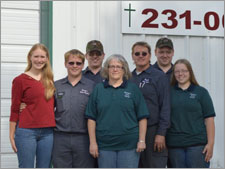
Call
620-231-0072 for service.
What do all those lights mean on my dash?
What color is the light? Think of a traffic light. There is red, yellow and green. Red means to stop! Yellow means caution. Most of the indicators on your instrument panel or dash are going to be red or yellow.
Any time there is a yellow indicator that comes on, you should use caution. you don't have to stop right now. Most times you can drive to repair shop and have it checked. Here are some of the yellow lights and what they mean.
There is a Check Engine light or Service engine soon, this is an indicator that tells you that there is a problem with the emission system or other computer controlled system on your car. You need to take your car to a repair shop to have computer system diagnosis done. If while driving this indicator comes on and flashes; this indicates that there is a misfire code set and the misfire is bad enough to cause damage to the catalytic converter. It will definitely hurt your fuel mileage and your car will produce excessive emissions. You should get your car to the repair shop as soon as possible.
The yellow anti-lock , ABS (anti-lock brake system), TCS (traction control system). These indicators light when there is a problem in that system that could render the system all or partially inoperative. When these indicators come on you need to get the vehicle in to have it checked. The base brake system should function normally.
The change oil soon indicator comes on when the computer determines sufficient miles since last reset. Some cars are can determine by using the coolant temperature and other sensors that the oil needs changed more often. The key to the oil change indicator is to have it reset when you get your oil changed even if it was not on when you had your oil changed.
The low tire indicator lets you know when the tire pressure in one tire is approximately 10 psi lower than the others. After checking and inflating all tires to the same pressure, some manufacturers require you to reset the tire inflation monitor.
Now lets discuss the red indicators. In most cases when a red indicator comes on it requires immediate action. Continuing to drive your vehicle could cause severe engine damage or your vehicle can not be safely operated. In most cases you need to call a tow truck.
The red oil pressure indicator comes on when the oil pressure in the engine gets below 5 psi. You need to pull off the road and SHUT THE ENGINE OFF. Check the oil level. If the oil level is full, then you need to have your vehicle towed to your repair shop. If the oil level is low, add oil until the level is full. Then start your engine and recheck the oil indicator or gage.
The temperature indicator or hot indicator comes on when the engine is overheating. If it comes on you need to pull off the road and SHUT THE ENGINE OFF. Look in the coolant overflow jug for coolant. If the overflow jug is empty you need to call a tow truck and have it towed to the repair shop.
There are several things that can turn on the red brake warning indicator. It comes on when the park brake is on . It can also come on when the brake fluid level in the master cylinder is low. In both of these cases you can check and release the park brake or fill the master cylinder with the proper fluid, and the indicator should go off. It can also come on if there is a problem with the base brake system, in which case you need to get it to a repair shop. Brakes can save your life, don't risk it. Have it towed to the repair shop.
The battery or charging indicator comes on when the charging system has quit charging. If this indicator comes on, DON'T SHUT THE ENGINE OFF. Turn off all accessories that are not absolutely necessary. Drive the car to a repair shop immediately or some place where you can leave your car. If you shut it off it may not restart.
The SIR (supplemental inflatable restraint system) or AIR BAG indicator comes on when the controller has detected a fault in the system. Depending on the fault the air bag may or may not go off. You need to get your vehicle to a repair shop if this indicator comes on. ALWAYS WEAR YOUR SEAT BELT ESPECIALLY IF YOUR CAR OR TRUCK HAS AN AIR BAG. YOUR SEAT BELT WILL POSITION YOUR BODY FOR THE DEPLOYMENT OF THE AIR BAG. SO ALWAYS WEAR YOU SEAT BELT.
Testimonials:
“I've had bad experiences with other mechanics.
It's a relief to find one I can TRUST!” J.S., Pittsburg
“You're all so friendly! And always there to help.
Thanks!” J.A., Frontenac
“You get more than 'Auto Repair', you get 'Service'.” D.W., Girard
The Crew:


